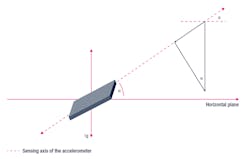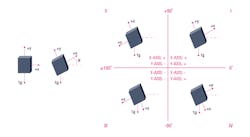An Introduction to Static and Dynamic MEMS Inclinometers
Members can download this article in PDF format.
What you’ll learn:
- What are static and dynamic inclinometers?
- Which one should you choose for your project?
- Not sure you need one? We’ve included a range of applications where an inclinometer adds value.
Precision and accuracy of an inclinometer are essential criteria when selecting one for a true value measurement. The gain, offset, noise, and cross-axis sensitivity in microelectromechanical-system (MEMS) devices are key determinants.
For many applications, the cost of a sensor often goes hand in hand with these key parameters. Because comprehensive calibration and trimming require additional time and equipment during manufacturing, higher-performance devices generally cost more.
Often used interchangeably, precision and accuracy are different (Fig. 1). Accuracy is the closeness of the device output to the true value. The closer the output is to the true value, the higher the accuracy.
Precision, on the other hand, is the closeness or grouping of the measurement points to each other. A wide spread of measurement data indicates low precision; a tight spread of measured points or grouping indicates a high precision. High-performance devices must provide both high accuracy and high precision data (Fig. 1c).
Static Inclination Measurement
Static inclination is the effect of earth’s gravity (g = 9.81 m/sec² or 32.2 feet/sec²) on the sensor’s axes of interest. An accelerometer measures the projection of the acceleration due to gravity on the axes of the sensor. However, in a real-world scenario, an inclinometer also may measure external acceleration, noise, and offset of the device. The impact of these components on the measurement of gravity effects must be negligible to achieve an accurate tilt calculation. If these external events are significant, the measured data must be compensated accordingly.
A MEMS-based accelerometer or inclinometer can be used to measure the tilt of an object with respect to a horizontal plane. The sum of forces measured on all three axes equals the force due to gravity (1g). Once these projections are obtained, one can use basic trigonometric equations to calculate the tilt angle with respect to each axis. Rotating the object changes the amplitude of the sensed acceleration according to the sine of the tilt angle (α) between the sensing axis and the horizontal plane.
The simplest tilt calculation is to use a single-axis inclinometer to measure the Earth’s gravity projected on the axis of interest. Figure 2 shows the tilt measurement using a single-axis inclinometer.
Figure 3 illustrates the Earth’s gravity components when a two-axis inclinometer measures the tilt. A two-axis accelerometer eliminates the drawbacks of a single-axis device for tilt measurement by enabling almost linear sensitivity and high resolution not limited to small angles (around 0°). It also offers the possibility to measure over the full 360° range. However, two different scenarios must be considered.
A three-axis device offers all of the benefits. These include nearly constant tilt sensitivity, the possibility to measure over 360°, and the flexibility to mount the device on the PCB in any orientation that meets system-architecture requirements.
Dynamic Inclination Measurement
Dynamic inclination is the tilt and slope of an objects position when it experiences rotation, vibration, motion, and shock, in addition to earth’s gravity.
The measurement of dynamic inclination is more complex than the static inclination measurement. The solution must include an accelerometer to determine the gravity vector and a gyroscope to measure the rotation of the object at the same time.
A MEMS-based dynamic inclinometer integrates both a three-axis gyroscope and a three-axis accelerometer for a real-time tilt measurement. In scenarios where accelerometer data is impacted by external acceleration interference, a three-axis gyroscope offers angular velocities around the three axes x, y, and z. This compensates for the interference. However, gyroscopes intrinsically suffer slight output data drift over time.
The combination of the gyroscope and accelerometer assures reliable and accurate dynamic tilt measurements. Usually, the data from the accelerometer and gyroscope are fused together and processed via a set of algorithms that are based on extended Kalman filters. This is sensor fusion.6
Inclinometer Performance Requirements
Several key performance requirements are relevant when selecting an inclinometer. The device’s number of axes is the first important indicator to consider. Depending on the application and system requirements, a single-axis, two-axis or a three-axis device can be selected. The offset/bias and gain of the sensor and their drift over time and temperature are of great importance.
The values of these indicators determine how frequently the sensor needs to be calibrated. The sensor’s measurement range for measuring the Earth’s gravity and rotation is another important specification. For a static inclinometer, usually a full-scale of ±1 g should suffice because it needs the Earth’s gravity components.
The sensor’s resolution is another important performance metric. It depends on the noise, bandwidth, filtering, and ADC (analog-to-digital conversion) resolution of the device. Higher-noise sensors can require further calibration, depending on the accuracy requirement of the application.
The stability of the offset and sensitivity over temperature determine the sensor’s accuracy. Accuracy also depends on vibration rectification error (VRE). The rectification to dc of broadband ac vibrations can shift the offset of the inclinometer, leading to significant errors.
Operating temperature range and whether the interface is analog or digital also can be important in some applications. Other performance specs include offset/sensitivity calibration error, post solder drift, cross-axis sensitivity, and nonlinearity. These may be less relevant because they can be measured and addressed with post-assembly calibration at ambient temperature. This calibration is often required for a high-accuracy inclinometer.
Inclinometer Applications
MEMS inclinometers are used in many applications because of their high stability over time and temperature, cost-effectiveness, low power consumption, and small size. MEMS static inclinometers also are easy to integrate, and they deliver long-term reliability in addition to their technical and cost advantages.
Inclinometers are being used to monitor structural health, prevent rollover in vehicles, and in robotics and accurate antenna and platform positioning.
One application emerging in the last few years is structural health monitoring (SHM). Here, the goal is to identify potential problems before structure fail. This application is part of predictive monitoring for safety and cost benefits. Sensors in SHM collect data over long periods of time to provide information on the overall condition of the structure.
Vibration, inclination, temperature, pressure, strain, and force data are the major components of structural monitoring systems. Collected regularly at appropriate time intervals, the sensor data can indicate the state of system health.
Dynamic inclinometers2 are useful in applications that require time-dependent information on the slope position and tilt of an object by offering a six-degree-of-freedom solution. Dynamic inclinometers implement sensor data fusion from an accelerometer and a gyroscope. This helps them reliably measure the angle of an object in motion when subjected to spurious accelerations.
Another common use of dynamic inclinometers is to monitor multiple simultaneous movements in robotics. Self-driving cars are among the latest emerging applications. These require hundreds of sensors to reliably collect large amounts of data at very high rates to accurately determine the vehicle’s position in real-time.
Conclusion
The latest MEMS inclinometers offer high performance and accuracy, high stability over time and temperature, and low power consumption—while being very cost-competitive. They’re very small and power-efficient, which makes them an ideal choice for many applications.
A static inclinometer outputs the Earth’s gravity components to calculate static tilt angle and slope position. Thus, any external motion and acceleration impacts the static inclinometer’s accuracy. In contrast, dynamic inclinometers are suited to applications where there’s motion, rotation, vibration, and acceleration. With these capabilities, both types of inclinometers will find their way into a wide range of applications.
References
1. High Precision Static MEMS Inclinometer.
3. High Precision Inclinometer for Industrial Applications.
4. Jay Esfandyari, Fabio Pasolini, Gang Xu, “Integrated smart systems with MEMS sensors,” Solid-State Technology, Feb 2012.
5. An Improved Calibration Technique for MEMS Accelerometer-Based Inclinometers.
6. Jay Esfandyari, Roberto De Nuccio, Gang Xu, “Solutions for MEMS sensor fusion,” Solid-State Technology 54(7) Follow journal, July 2011.
About the Author
Jay Esfandyari
STMicroelectronics
Jay Esfandyari has more than 20 years of industry experience in semiconductors and has authored and co-authored several papers on solid-state physics and MEMS technology and sensors. He also has contributed to many conferences with topics on MEMS sensors. Jay holds a master's degree and a Ph.D. in Electrical Engineering.



